HSF: Hearing and Music (W7)
1/25
There's no tags or description
Looks like no tags are added yet.
Name | Mastery | Learn | Test | Matching | Spaced |
|---|
No study sessions yet.
26 Terms
Structures involved in hearing (image)
Inner ear bone + common name:
malleus - hammer
incus - anvil
stapes - stirrup
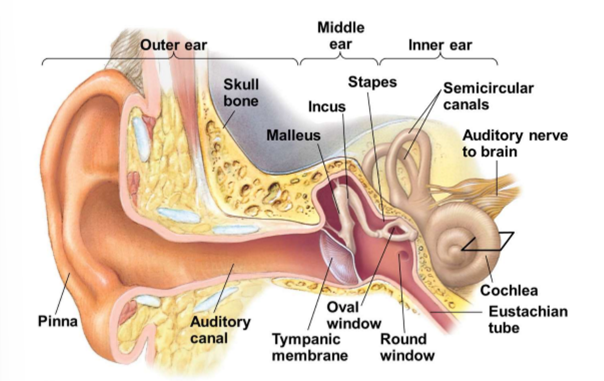
the cochlea
is made up of 2 fluid filled chambers separated by a cochlear duct
has hairs with different flexibilities = so can tell difference between sounds + frequencies
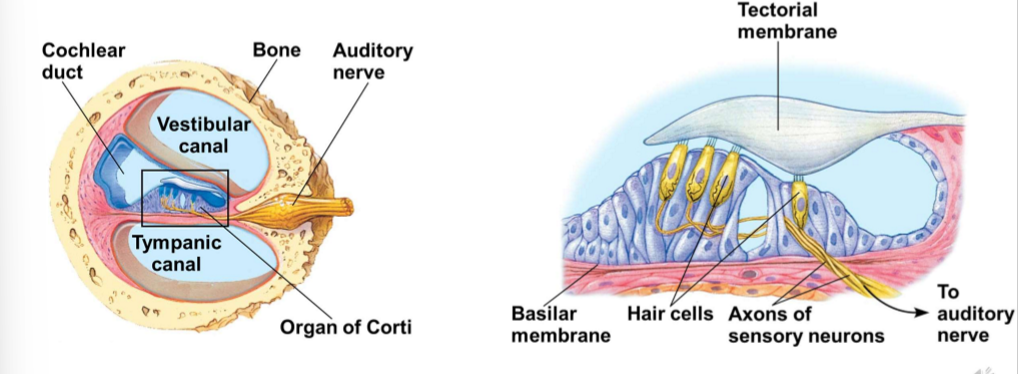
Vibrations
vibrations from the stapes → causes vibrations to the oval window on the surface of the cochlea
this creates pressure waves to the fluid inside the cochlea
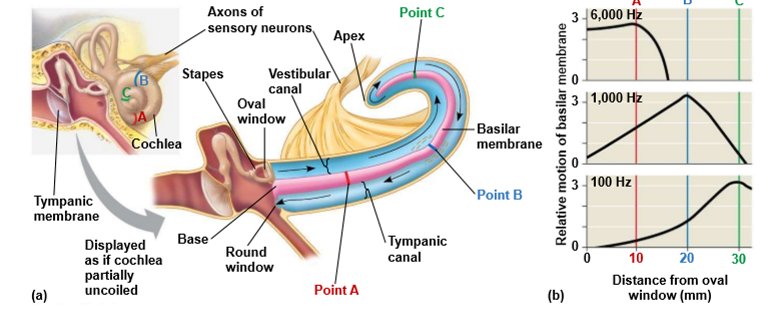
how do films use music to create a mood?
sensory coding:
low visual processing
detection of stimulus at retina/eardrum
the stimulus itself
cognitive coding:
content + context
cognitive coding decides whether you like music or not e.g. some people really like loud music
How do we feel emotions?
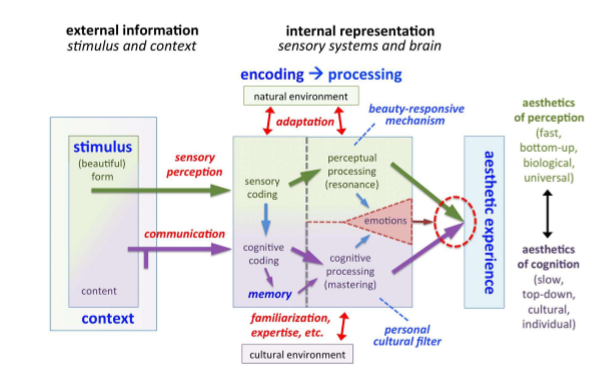
Chat GPT explanation of the model
This diagram from Redies (2015) explores how aesthetic experiences (like perceiving something as beautiful) arise from a mix of sensory, cognitive, and cultural processes. It links external stimuli with internal brain processing to explain how we perceive and interpret beauty.
🔄 Left to Right Flow: From Stimulus to Aesthetic Experience 🔹 1. External Information
Stimulus (e.g., a beautiful form): The physical appearance or structure of something.
Context: Includes meaning, setting, or cultural background.
These two are input into our perception system.
🔹 2. Internal Representation
This is how our brain and sensory systems process the input:
🔵 Sensory perception (red arrow)
Immediate processing of form, color, shape, etc.
Leads to sensory coding — basic recognition of the object.
🔵 Cognitive processing (purple arrow)
Involves memory, learning, expertise, and prior knowledge.
Heavily shaped by culture and environment.
🔁 Adaptation & Familiarization
Over time, exposure to certain types of stimuli (like cultural norms) shapes what we perceive as aesthetically pleasing.
🎯 Aesthetic Experience
At the center of the diagram is the emergence of aesthetic experience, a combination of:
Perceptual processing (bottom-up, fast, sensory) → universal and biological
Cognitive processing (top-down, slow, meaning-based) → personal, cultural
This results in the subjective feeling of beauty, filtered through both innate responses and learned preferences.
🧠 Right Side Labels: Two Processing Models 📏 Formalist Model
Focuses on sensory and universal aspects.
Relies on object recognition and biological mechanisms.
Example: Everyone finds symmetry or certain patterns visually appealing.
🌍 Conceptual Model
Emphasizes cognitive, cultural, and individual influences.
Beauty is affected by learning, context, and social norms.
Example: Cultural variation — e.g., less nudity in Asian films compared to Western ones due to different norms.
Test - Can background music affect our feelings towards characters?
Watch same vid with different background music
conclusions:
different music changes how we feel towards the character
music in film contributes to the aesthetics + can influence how we feel towards a character
demonstrates importance of music + context in film
Test M - does music affect perception of morality?
Showed 2 clips with different music
252 (113 female)
music: negative, positive or no music
i called it test M just bc its about morality its not acc called that
Test M - emotional choices (image)

Test M - ANOVA
Hypothesis 1: Music can influence the emotions felt when watching a scene
found no significant difference between the videos
Test M - Pearsons
Hypothesis 2: Emotions induced by stimuli affect perceived moral righteousness
did see significant difference between the 2 videos
money video → 2x more likely to be affected by emotions
Can music influence perceived morality?
results for test M = inconclusive
positive emotions associated with perceived righteousness of scene
were the clips too controversial?
Causes of hearing loss
anything that causes blockages to auditory canal → stop sound getting in
damage to structures e.g. eardrum → stops sound from being transferred to cochlea
Can be corrected:
e.g. if hearing loss sustained through too much loud music or from birth → using a hearing aid
Example causes of hearing loss (image)
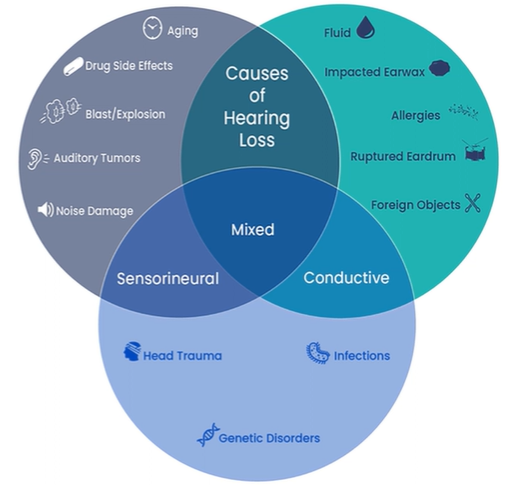
Music in film for deaf/hard of hearing individuals
film mood boosted by music
accessible through subtitling
description (e.g. ‘suspenseful music’)
details (e.g. name)
writing out lyrics
Different companies have different guidelines for music in subtitles
Netflix - transcribe song lyrics +/ provide artist + title
BBC - transcribe song lyrics and give author + title of identifiable music
if only for atmosphere - describe
Which subtitles are most useful: Survey 1 (Szarkowska + Laskowska, 2014)
Survey of 160 deaf (d), 78 hard of hearing (h), Polish ppts
conditions:
mood of music (e.g. ‘cheerful music’)
d - 65.5%
h - 61.4%
type of music (e.g. ‘guitar music’)
d - 40.6%
h - 29.5%
presence of music (e.g. ‘music’)
d - 17.5%
h - 28.2%
Which subtitles are most useful: Survey 2 (Szarkowska, Pietrulewicz + Laskowska, 2015)
Survey of 110 deaf (d), 45 h Polish ppts
conditions:
title of song on screen - 49%
info on what type of music it is - 11%
musical notes - 16%
none - 16%
What is most useful: Test 3 clips (Aleksandrowicz, 2020)
3 clips
E1 - The Shining (REDRUM) = fear
E2 - Dead man walking (execution) = sadness
Control clip - The Shining (car on mountain road)
Conditions:
20 d + 20 h → control
scary music + name
20 d + 20 h → emotive clip 1
scary music + name
20 d + 20 h → E2
sad music + name
26 control (hearing) → all 3 clips
all no subs
Conclusions from Aleksandrowicz, 2020 study
no significant difference between emption felt + subtitling or c,h or d ppts
found that use of subtitling alone could NOT influence emotion if this is not reflected on screen
details od music playing was most useful
caption (e.g. ‘scary music’) → built up anticipation
Are there differences in music appreciation in cochlea ear implant patients with significant prelingual + post lingual (later in life) hearing loss?
Prelingual significant hearing loss = loss before 3 years old
Varies causes + individual modes of communication
Long term auditory depravation → degeneration of auditory system → reduced development of language processing areas of auditory cortex
STUDY - Are there differences in music appreciation in cochlea ear implant patients with significant prelingual + post lingual (later in life) hearing loss? (Moran et al, 2006)
30 patients with Cochlea implants
15 preL + 15 postL onset
findings:
hearing impairments + enjoyment of music impacts post lingual individuals the most
Does PreL / PostL affect music recognition?
PostL recognised + identified melody/style more readily than PreL group
Conclusions from Moran et al, 2006 study
hearing loss affects music listening participation more greatly in PostL individuals
Cochlea implant makes larger implant on music participation in PostL
PreL individuals identified melody / style less readily compared to postL
Music enjoyment comparable for both
Summary
human structures link sensory info + allow for this to be processed by nervous system
emotions are not just a physical response, but have environmental input
music can help to promote some emotions in film
however - no formula of exact emotion by any musical addition